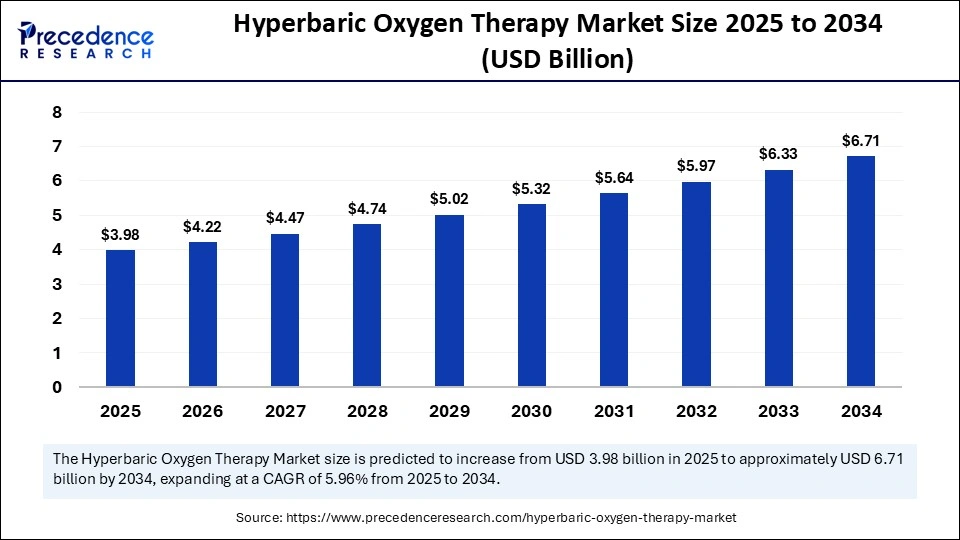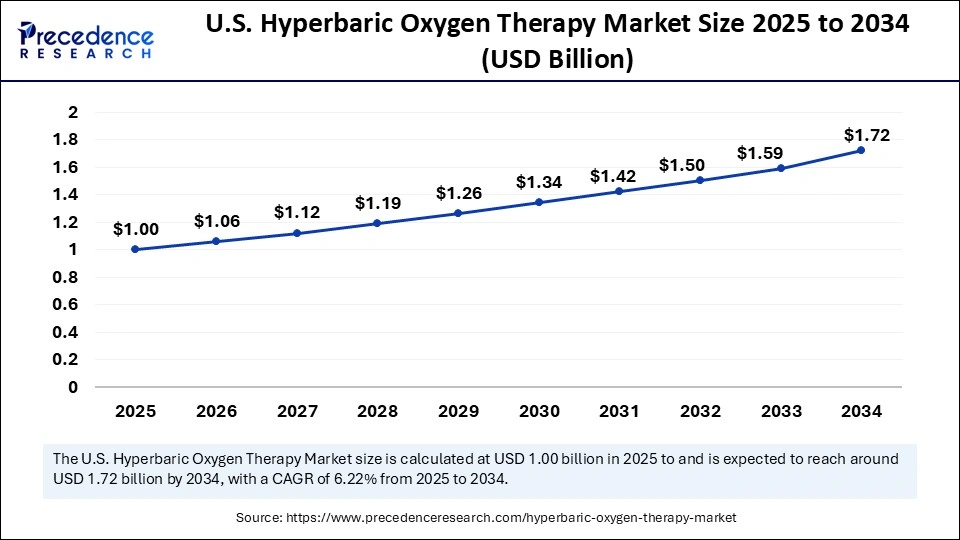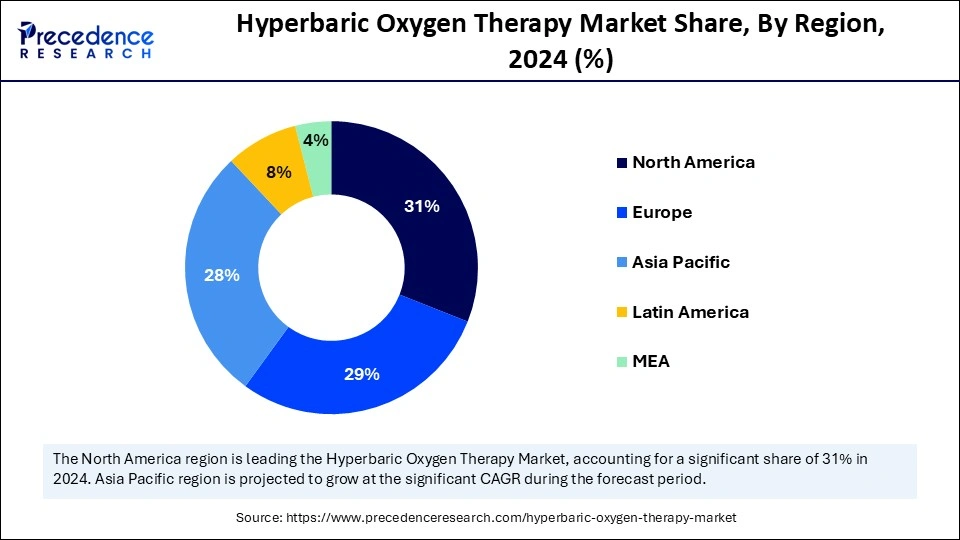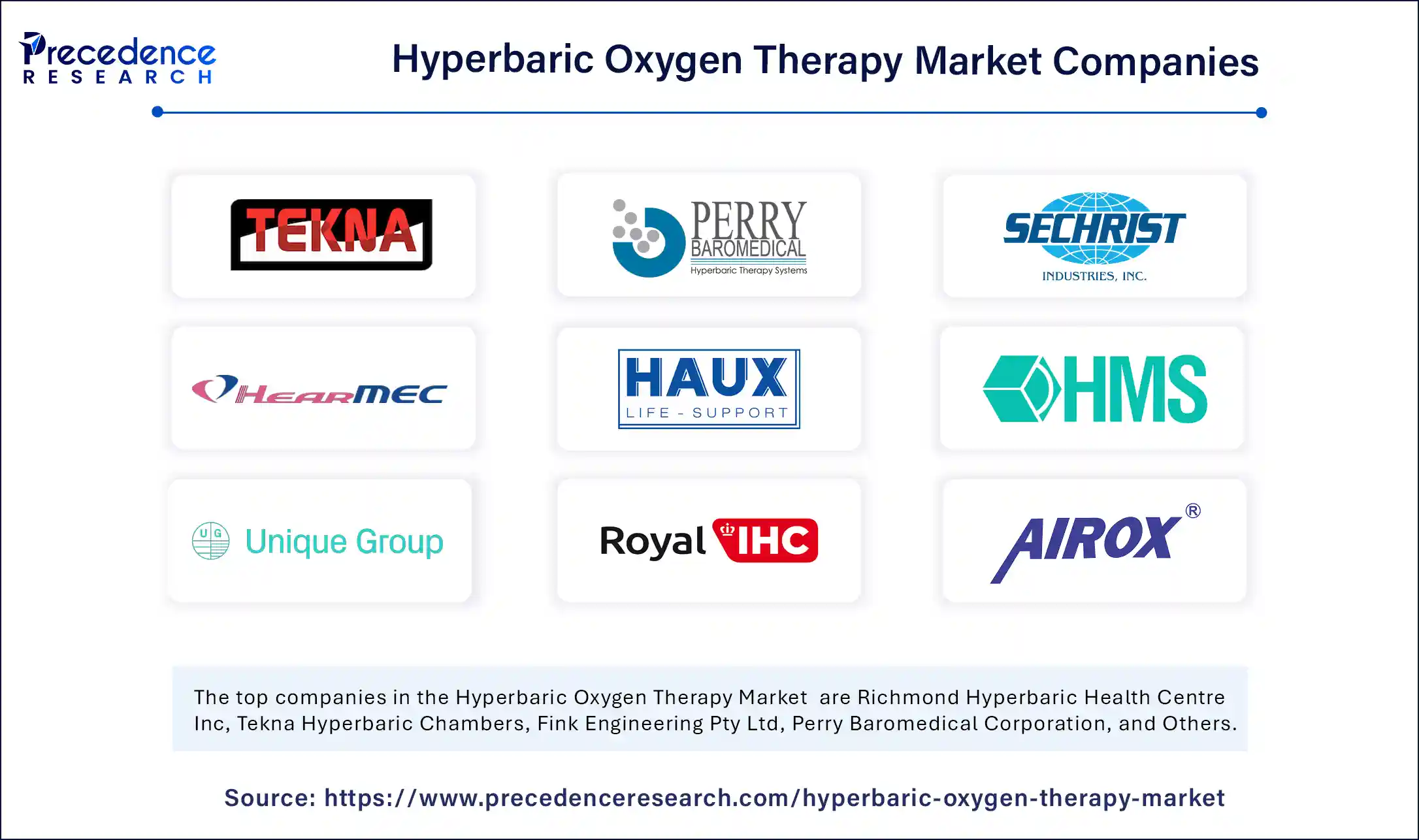List of Contents
What is the Hyperbaric Oxygen Therapy Market Size?
The global hyperbaric oxygen therapy market size is calculated at USD 3.98 billion in 2025 and is predicted to increase from USD 4.22 billion in 2026 to approximately USD 6.71 billion by 2034, expanding at a CAGR of 5.96% from 2025 to 2034. The growth of the hyperbaric oxygen therapy market is driven by rising incidences of chronic wounds, increasing awareness about advanced treatments, and the expanding scope of applications of hyperbaric oxygen therapy in neurological conditions.

Hyperbaric Oxygen Therapy Market Key Takeaways
- North America accounted for the highest revenue share of 31% in 2024.
- Asia Pacific is expected to grow at a CAGR of 6.5% between 2025 and 2034.
- By type, the monoplace chambers segment held the largest market share in 2024.
- By type, the multiplace chambers segment is expected to grow at a significant CAGR during the forecast period.
- By application, the wound healing segment captured the biggest market share in 2024.
- By application, the decompression sickness segment is expected to expand at the fastest CAGR over the projected period.
- By end user, the hospitals segment captured the biggest market share in 2024.
- By end user, the home care segment is expected to expand at a rapid pace during the projection period.
What are the impacts of AI on the Hyperbaric Oxygen Therapy Market?
By integrating artificial intelligencemodels with health records and imaging systems, the decision-making process is greatly accelerated, leading to improved patient outcomes. While real-world data extraction and analysis was previously painstaking and time-consuming, AI can analyze the information captured in electronic health records and image repositories very quickly to create personalized treatment plans, optimizing the effectiveness of hyperbaric oxygen therapy. AI also helps with patient monitoring. With AI-driven RPM tools, continuous monitoring of patients during hyperbaric oxygen therapy is possible. This, in turn, reduces anomalies and enhances patient outcomes.
What is Hyperbaric Oxygen Therapy?
Hyperbaric oxygen therapy (HBOT) is a medical treatment in which a patient breathes pure oxygen in a pressurized chamber to increase oxygen delivery to tissue. This process increases the amount of oxygen delivered to the tissue and leads to increased healing in conditions such as non-healing wounds, carbon monoxide, decompression sickness, and radiation injuries. The hyperbaric oxygen therapy market is poised for consistent growth due to the increasing incidence of non-healing wounds and complications related to diabetes. With various emerging applications in the neurology field, the demand for HBOT continues to grow relative to mainstream medical practices.
The rising development of portable hyperbaric chambers and research suggesting advances in wound care further contribute to market growth. The number of clinical practices that are incorporating HBOT in their practice has increased over the years. There is continued innovation in the hyperbaric chamber, which is likely to sustain market growth in the near future.
What are the Growth Factors of the Hyperbaric Oxygen Therapy Market?
- Increased incidence of chronic wounds: The growing incidence of patients with diabetic foot ulcers, pressure ulcers, and non-healing wounds is driving demand for HBOT.
- Expanding the scope of applications: HBOT is being studied and utilized for indications such as traumatic brain injury, stroke recovery, and cosmetic skin care, which enlarges its clinical applications.
- Aging population: With a growing older population presenting with increased moral and vascular complications, there is more need for advanced healing therapies like HBOT.
- Technological advancements: Newer portable and multi-place hyperbaric chambers equipped with better safety features make therapy more accessible and effective.
- Increased awareness and healthcare expenditures: Increased public awareness and professional discipline awareness, coupled with improvements in healthcare development and spending, is providing the climate to support a broader application of HBOT.
Hyperbaric Oxygen Therapy Market Outlook
- Industry Growth Overview: The hyperbaric oxygen therapy (HBOT) market is anticipated to experience continuous growth from 2025 to 2030, as a result of the increased demand for treating wounds, rehabilitation for sports injuries, and healing following surgery. As hospitals and specialty clinics began adapting advanced treatments closely related to value-added systems, utilization increased.
- Global Expansion: Several leading HBOT companies began expanding into Southeast Asia, Eastern Europe, and LATAM in order to reach the underserved populations and opportunities resulting from government healthcare reforms. Many companies-built assembly or service structures locally in order to reduce transportation costs and increase the opportunity for compliance with regulatory requirements.
- Major Investors: Private equity and large healthcare investors became more active in the HBOT market as a result of strong clinical relevance, a favorable reimbursement structure, and some level of technological differentiation. Firms like Carlyle and Blackstone specifically targeted medical device companies with promising IP portfolios and recurring service revenue, providing a boost to their innovation pipelines.
- Startup Ecosystem: The emerging startup landscape in HBOT expanded and gained traction, especially in portable chambers, AI-based monitoring devices, and telehealth therapy platform development. Emerging companies headquartered in the U.S., Israel, and India stood out to high-profile venture capital firms by marketing devices that are less expensive, scalable, and primarily designed for home care and sports rehabilitation.
Market Scope
| Report Coverage | Details |
| Market Size by 2034 | USD 6.71 Billion |
| Market Size in 2025 | USD 3.98 Billion |
| Market Size in 2026 | USD 4.22 Billion |
| Market Growth Rate from 2025 to 2034 | CAGR of 5.96% |
| Dominating Region | North America |
| Fastest Growing Region | Asia Pacific |
| Base Year | 2024 |
| Forecast Period | 2025 to 2034 |
| Segments Covered | Type, Application, End-User and Region |
| Regions Covered | North America, Europe, Asia-Pacific, Latin America, and Middle East & Africa |
Market Dynamics
Drivers
Increasing Prevalence of Diabetes and Technological Advancements
The increasing prevalence of diabetes across the world is a significant factor driving the growth of the hyperbaric oxygen therapy market. According to the World Health Organization (WHO), in 2021, there were about 537 million adults aged between 20-79 years living with diabetes and it is expected to rise to 643 million by 2030 and 783 million by 2045. The increasing prevalence of diabetes leads to an increase in the number of cases of diabetic foot ulcers and chronic wounds, significantly creating the need for HBOT. HBOT works by driving oxygen into hypoxic tissue, which promotes angiogenesis, helps resolve the sclerosis of the wound, and reduces the incidence of amputation. In addition to the increasing use of HBOT to treat diabetes-related complications, there is continuous innovation in hyperbaric oxygen therapy. Advancements in hyperbaric chambers, including portable and user-friendly chambers, are improving the efficiency and safety of HBOT to be utilized in hospital settings and ambulatory care centers.
(Source: https://www.emro.who.int)
Restraint
High Costs and Safety Concerns
Despite its therapeutic advantages, hyperbaric oxygen therapy (HBOT) is not widely adopted because of significant barriers. The high costs associated with HBOT and limited reimbursement policies limit accessibility to some patients, especially those in low-income groups. Safety issues also have been highlighted by the sudden hyperbaric chamber explosion in Michigan in January 2025, which led to the death of a five-year-old boy. In addition, there are concerns about the adequacy of safety measures and regulatory procedures in HBOT facilities.
(Source:https://www.holmesmurphy.com)
Furthermore, side effects associated with HBOT, including seizures, toxicity, and injuries to the middle ear, create the need for extensive screening and safety precautions for patients. These include safety protocols and the need for qualified personnel. Together, these issues evoke hesitation from both patients and practitioners, resulting in significant barriers to broader market expansion.
Opportunity
Integration of HBOT into Wellness and Home-Based Care
The hyperbaric oxygen therapy market is experiencing a revolutionization through the market's entry into luxury wellness and home care models. There is a marked increase in the number of HBOT chambers being installed in luxury real estate, particularly in cities like London, Los Angeles, and Dubai, where "longevity rooms" are becoming the new status symbol. The longevity rooms include bio-optimization tools like HBOT units with other amenities desired for enhancing cognitive performance, anti-aging, and physical recovery. At the same time, social wellness clubs like Remedy Place in New York are offering HBOT as part of a collective health experience.
Technological advancement has now made it possible for patients to receive HBOT under the supervision of healthcare personnel through telemedicine platforms. This enables patients to recover from a wound or injury at the convenience of their homes. This decentralization of therapy delivery supports the broader trends in telehealth and is likely to increase market reach, especially as more wellness practices become paramount to individualized healthcare.
Type Insights
Why did the Monoplace Chambers Segment Dominate the Market in 2024?
The monoplace chambers segment dominated the hyperbaric oxygen therapy market with the largest revenue share in 2024. This is mainly due to their affordability, simplicity, and ability to fit well within multiple healthcare environments, such as hospitals and ambulatory surgical centers. Monoplace chambers allow for single use and mitigate cross-contamination risks, simplifying infection control for clinical settings. They are suitable for smaller-level facilities, so outpatient centers and private clinics can use monoplace chambers. The ease of installation and cost-effectiveness of these chambers are crucial factors supporting segmental growth.
The multiplace chambers segment is expected to grow at a significant CAGR during the forecast period. The adoption of multiplace chambers is rising rapidly due to their ability to treat up to 14 patients in one cycle. These chambers are valuable in general emergency care and for large hospitals, particularly for mass injuries or decompression sickness affecting groups like military personnel or divers. The use of multiplace chambers is also increasing as knowledge of hyperbaric medicine rises and trauma center regulations incorporate the representation of hyperbaric medicine. Furthermore, multiplace chambers offer specific advantages in hospital settings, enabling treatment for patients requiring mechanical ventilation or intensive monitoring.
Application Insights
Which Application Segment Dominated the Hyperbaric Oxygen Therapy Market in 2024?
The wound healing segment dominated the market with the largest revenue share in 2024. This is mainly due to the efficacy of HBOT in promoting tissue repair and reducing the risk of infection. It can be very effective for chronic, non-healing wounds, such as diabetic foot ulcers, pressure ulcers, and injuries from radiation therapy. The worldwide increase in the incidence of diabetes and peripheral vascular disease has led to more clinical adoption of hyperbaric oxygen therapy in wound care centers and hospitals. As evidence supporting its efficacy accumulates, this treatment is becoming a core therapy in advanced wound care.
The decompression sickness segment is expected to expand at the fastest CAGR over the projected period, driven by the increasing number of recreational scuba divers and professional diving operations. As more people take part in underwater-related activities, the need for emergency decompression treatment increases. In addition, segment growth can be attributed to the increasing awareness of health issues associated with diving and the establishment of hyperbaric facilities in remote areas and close to water. Military and commercial diving units continue to buy hyperbaric chambers, contributing to segmental growth.
End User Insights
How Does the Hospitals Segment Dominate the Market in 2024?
The hospitals segment dominated the hyperbaric oxygen therapy market in 2024 since they have advanced infrastructure and can offer robust medical services under a single roof. Hospitals also typically have skilled staff and monitoring equipment, which are necessary when using hyperbaric chambers skillfully and safely, particularly in complicated cases such as carbon monoxide poisoning, secondary infections, and chronic wounds. The rise of hyperbaric units being included in multidisciplinary hospital services enhances wider accessibility to HBOT, especially in urban healthcare systems. Hospitals also have established reimbursement systems for hyperbaric oxygen therapy, contributing to the growth of the segment.
The home care segment is expected to expand at a rapid pace during the projection period as patients are increasingly preferring home treatments, especially elderly and chronically ill patients. The development of portable hyperbaric chambers and RPM have enabled patients to receive therapy in the convenience of their homes under medical supervision. Home healthcare providers are also expanding their service offerings to include this advanced therapy.
Regional Insights
U.S. Hyperbaric Oxygen Therapy Market Size and Growth 2025 to 2034
The U.S. hyperbaric oxygen therapy market size is exhibited at USD 1.00 billion in 2025 and is projected to be worth around USD 1.72 billion by 2034, growing at a CAGR of 6.22% from 2025 to 2034.

What Factors Contributed to North America's Dominance in the Hyperbaric Oxygen Therapy Market?
North America registered dominance in the market by capturing the largest revenue share of 31% in 2024. Factors such as accredited hyperbaric centers by the Undersea & Hyperbaric Medical Society (UHMS), the presence of robust healthcare infrastructure, and the prevalence of chronic wounds and inflammation due to diabetes are major factors that contribute to regional market growth. The favorable regulatory environment and the availability of reimbursement policies for HBOT bolstered the growth of the market in the region. The region's dominance is reinforced by the US's longstanding commitment to the healthcare, supported by federal government insurance programs and private insurers, ensuring support for hyperbaric treatment. Clinical research and the growing awareness of hyperbaric therapy benefits for radiation injury and carbon monoxide further support regional market growth. Additionally, the presence of major market players and investments into medical technology further solidify the region's position in the market.
North America: U.S. Hyperbaric Oxygen Therapy Market Trends
The rising prevalence of chronic wounds, especially from diabetes, and other hard to heal injuries is a major demand driver. There is increasing use of HBOT in outpatient clinics and specialized wound-care centers, supported by technological innovations like portable and smart chambers. Applications are also expanding beyond traditional indications like decompression sickness to newer areas such as neurological injury, radiation therapy recovery, and sports medicine.
European Hyperbaric Oxygen Therapy Market Trends
Europe was the second-largest market in 2024 and is expected to grow at a significant rate in the upcoming period, mainly due to its highly developed healthcare systems, robust reimbursement structures, and increasing patient demand for non-invasive treatments. The rising burden of chronic wounds, post-surgical complications, and neurological conditions is boosting the acceptance of hyperbaric oxygen therapy (HBOT). Germany is a significant player in the European hyperbaric oxygen therapy market. It has a well-developed network of accredited hyperbaric facilities, improving accessibility to HBOT and facilitating rapid integration in hospitals and clinics for the treatment of common ailments such as vascular conditions, traumatic brain injuries, or sports injuries.
Europe: Germany Hyperbaric Oxygen Therapy Market Trends
Germany's market is growing steadily, driven by increasing clinical adoption in wound healing (especially diabetic ulcers) and neurological recovery settings. There is a clear trend toward monoplace chamber systems, which are favored for their lower cost, simpler operation, and higher patient comfort. Innovation is strong, German companies are developing smart and modular HBOT chambers with IoT-enabled monitoring and AI-driven control.

Asia Pacific Hyperbaric Oxygen Therapy Market Trends
Asia Pacific is projected to grow at a CAGR of 6.5% during the forecast period. The growth of the market within Asia Pacific is driven by increasing healthcare spending, growing awareness of treatment options, and the growing middle-class population. There is rising demand for non-invasive therapies to treat chronic wounds, aid recovery from surgery, and treat complications from diabetes, supporting regional market growth. Medical tourism in countries such as India, Thailand, and Malaysia is rising, leading to increased demand for HBOT to attract international patients. Improved hospital accessibility and favorable reimbursement policies are also accelerating the adoption of HBOT.
China is a major force in the market due its large patient pool, government-driven healthcare reforms, investment in hospital infrastructure, and the integration of HBOT across hospitals for treating various conditions, including diabetic foot ulcers, neurological injuries, and wounds. Public and private hospitals are equipped with more modern hyperbaric chambers, and research institutions are investing heavily in clinical trials using HBOT for diverse indications. These factors contribute to market growth.
What made the Latin American region grow at a Considerable Rate in the Hyperbaric Oxygen Therapy Market?
Latin America experienced considerable growth due to the upward trend in hospital systems utilizing modern therapies and the overall general medical awareness around HBOT. As the prevalence of chronic wounds, chronic burns, and chronic infections rises, the demand will ultimately be pushed even higher. Moreover, an increase in government investments in healthcare has also improved access to advanced treatment modalities. With developing hospital infrastructures and growing interest from global device manufacturers in the region, Latin America is continuing to rise in the forecast period.
Brazil Hyperbaric Oxygen Therapy Market Trends
Brazil led the region with large hospitals, a growing private healthcare sector, and increased medical tourism. A lot of clinics utilize HBOT for diabetic wounds, infections, and sports injuries. Government programs aimed at improving wound care experienced higher acceptance of HBOT services. With increased chronic disease prevalence and growing access to the latest devices, Brazil remains the lead market in Latin America for HBOT.
Why did the Middle East and Africa grow steadily in the Hyperbaric Oxygen Therapy Market?
The Middle East and Africa organizations grew steadily due to advanced hospital infrastructure, rising chronic disease cases, and demand for advanced therapy. Wealthier countries have invested heavily in modern HBOT chambers specifically for surgical recovery and wound-care applications. Awareness grew extremely in the African nations where clinics updated equipment to include HBOT. The region was showing strong opportunities as a result of increased medical tourism and private healthcare spending. Global manufacturers also began entering the market and stimulating development in both subregions.
The UAE Hyperbaric Oxygen Therapy Market Trends
The UAE showed all signs of leading the region because it had heavily invested in modern hospital organizations, advanced wound-care centers, and, specifically, in premium medical devices. Several clinics began to add HBOT to their recovery process, specifically with regard to burns, degenerative diseases, and or sports injury.
Hyperbaric Oxygen Therapy Market Companies

- Richmond Hyperbaric Health Centre Inc
- Tekna Hyperbaric Chambers
- Fink Engineering Pty Ltd
- Perry Baromedical Corporation
- Gulf Coast Hyperbarics Inc
- Sechrist Industries Inc.
- HearMec Co
- SOS Group
- Haux-Life-Support GmbH
- Hyperbaric Modular Systems, Inc.
- Pan-America Hyperbarics Inc
- Unique Group FZC
- Royal IHC
- Hyperbaric SAC
- Airox Technologies Limited
- Hipertech Electronics Inc.
- Environmental Tectonics Corporation (ETC)
Recent Developments
- In February 2025, Altru Clinic launched Hyperbaric Oxygen Therapy (HTBO) at Altru Clinic, located at 1300 South Columbia Road in Grand Forks. This treatment is going to allow many patients to restore health and promote healing.
(Source: https://www.altru.org) - In January 2025, HCG Manavata Cancer Centre (HCG MCC) launched its Hyperbaric Oxygen Therapy (HBOT) department, aimed at accelerating healing and enhancing recovery for patients. The advanced HBOT infrastructure at HCG MCC is designed to accommodate up to four patients simultaneously, offering a significant upgrade from traditional monoplace chambers.
(Source: https://www.expresshealthcare.in)
Segments Covered in the Report
By Type
- Monoplace Chambers
- Multiplace Chambers
- Others
By Application
- Wound Healing
- Type
- Chronic Wounds
- Acute Wounds
- Type
- Decompression Sickness
- Others
By End-User
- Hospitals
- Home Care
- Others
By Region
- North America
- Europe
- Asia-Pacific
- Latin America
- Middle East and Africa
For inquiries regarding discounts, bulk purchases, or customization requests, please contact us at sales@precedenceresearch.com
Frequently Asked Questions
Ask For Sample
No cookie-cutter, only authentic analysis – take the 1st step to become a Precedence Research client